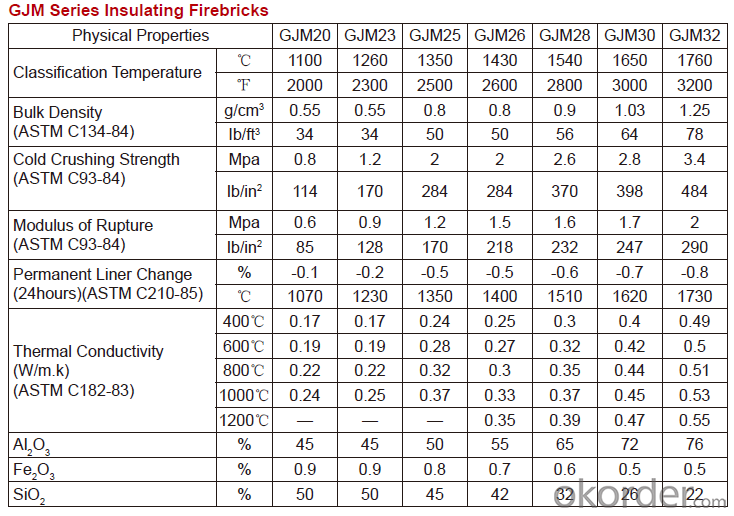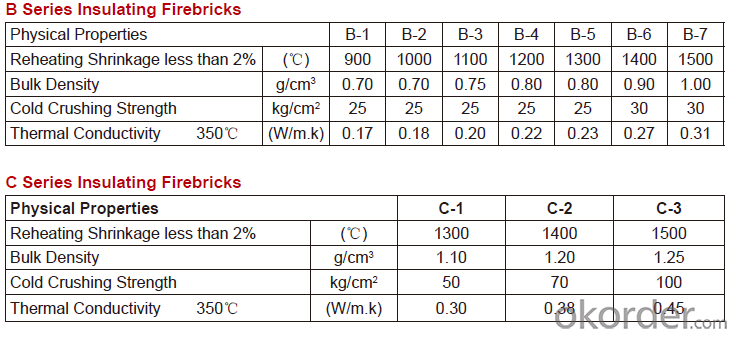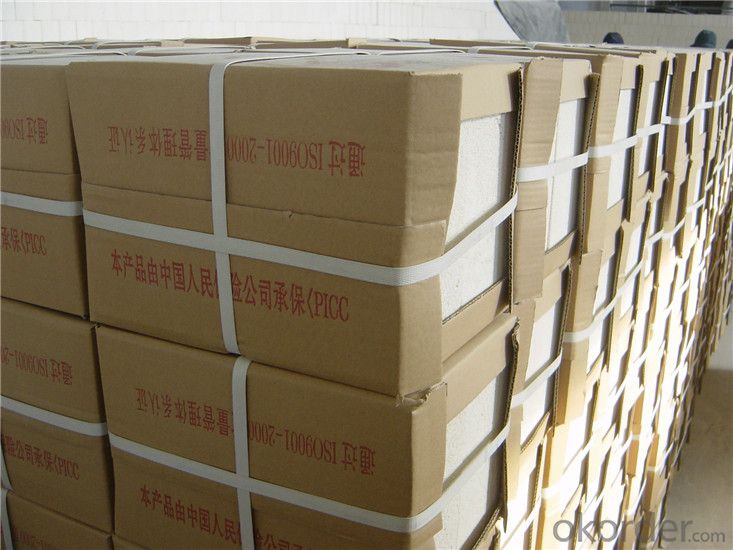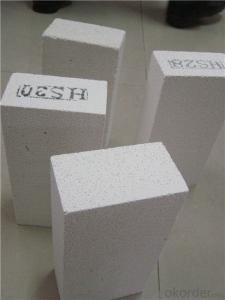Mullite Insulation Brick JM Series,Alumina Insulation Brick,Insulation Mullite Brick
- Loading Port:
- Shanghai
- Payment Terms:
- TT OR LC
- Min Order Qty:
- 1 m.t.
- Supply Capability:
- 1000 m.t./month
OKorder Service Pledge
OKorder Financial Service
You Might Also Like
Thermal Insulation Fire Clay Brick
Refractory brick is a block of refractory ceramic material used in lining furnaces, kilns, fireboxes, and fireplaces.
We provide high quality Refractory Fire Bricks that are used on wide range in the various industries like Cement, Glass and Steel. Refractory Fire Bricks are provided as per the quantity and specifications required by the customers. We provide an extensive range of Refractory Fire Bricks at reasonable prices that depend upon the quantity ordered.
Application
Insulating Fire Brick are used for the lining of converter, alternating current arc furnace, direct Current arc furnace and the ladle slag line, etc.
Company Advantage
(1)Long Insulating Fire Brick manufacture history: 25 years manufacturer
(2)Advanced equipment
(3)Diversification of production standards: ISO ANSI FEPA JIS ASTM
(4)Flexible payment: T/T L/C D/P D/A
(5)Professional marketing team and after-sale service
Insulating Fire Brick main feature:


Equipment
1 unit of Ceramic Abrasive (SG Abrasive) pilot production line
2 units of Compact grain Abrasive pilot production lines
1 unit of high-end coated abrasives (abrasive cloth) production line
2 units of Boron Carbide production lines
3 large flexible crushing and sieving lines for grit production lines
6 units of 5000KVA-10000KVA dumping type electric arc furnaces for Brown Fused Alumina fusion
Q1 What’s the transport method?
A1 FCL delivery goods with wooden pallet or wooden case by sea; If LCL delivery, must with wooden case; Sometimes need open top, flat rack or bulk cargo.
Q2 What’s the required payment term?
A2 Generally 30% TT as the prepayment, 70% TT before delivery. If need, 100% Irrevocable Letter of Credit or negotiation.
Q3 Which country are our products exported to?
A3 Apart from entire Chinese market, the US, Russia, Japan, Korea, Australia and some Southeast Asian Nations.


- Q:Are insulating fire bricks resistant to gas permeability?
- Insulating fire bricks possess gas impermeability, as they are engineered with low porosity and high density. These bricks are crafted from superior refractory materials like clay or silica and undergo a unique manufacturing process that guarantees minimal pore size and compactness. Consequently, they excel at containing gases and averting leakage. Widely employed in high-temperature settings such as furnaces, kilns, and industrial boilers, insulating fire bricks play a critical role in ensuring efficient and safe operations by maintaining gas tightness.
- Q:Are insulating fire bricks resistant to thermal radiation?
- Yes, insulating fire bricks are resistant to thermal radiation. These bricks are specifically designed to have excellent thermal insulation properties, which means they can effectively resist and minimize the transfer of heat by radiation. Insulating fire bricks are typically made from materials such as alumina, silica, or fire clay, which have high melting points and low thermal conductivity. This combination of properties allows them to withstand high temperatures and prevent the flow of thermal energy through radiation, making them a suitable choice for applications where thermal insulation is required, such as kilns, furnaces, and fireplaces.
- Q:What materials are used to make insulating fire bricks?
- Various materials possessing high thermal insulation properties are used to manufacture insulating fire bricks. The primary material utilized in producing these bricks is kaolin clay, a type of clay renowned for its insulation characteristics. To enhance its insulating properties and increase its resistance to high temperatures, this clay is mixed with other additives such as alumina, silica, and zirconium. Furthermore, materials like sawdust, vermiculite, perlite, and calcium silicate are occasionally added to the mixture to further enhance the bricks' insulation capabilities. Collectively, these materials enable insulating fire bricks to exhibit low thermal conductivity, exceptional heat resistance, and excellent insulation qualities, rendering them suitable for a broad range of industrial and domestic applications.
- Q:Can insulating fire bricks be painted or coated?
- Insulating fire bricks can be painted or coated, but it is important to use high-temperature paint or coating specifically designed for use with these bricks to ensure durability and fire resistance.
- Q:Do insulating fire bricks require any special fireproofing treatments?
- There is no need for any special fireproofing treatments for insulating fire bricks. Insulating fire bricks are composed of lightweight materials that possess excellent insulation properties, such as refractory clay or ceramic fibers. These materials possess inherent fire resistance and can endure high temperatures without requiring extra fireproofing treatments. Nevertheless, it is crucial to guarantee the correct installation and utilization of insulating fire bricks in order to enhance their efficiency and lifespan.
- Q:Can insulating fire bricks be used in the construction of industrial boilers?
- Yes, insulating fire bricks can be used in the construction of industrial boilers. Insulating fire bricks are specially designed to have low thermal conductivity, which means they are excellent at retaining heat and are ideal for applications where high temperatures need to be maintained. In the case of industrial boilers, insulating fire bricks can be used as lining material in the combustion chamber and other areas of the boiler where insulation is required. The use of insulating fire bricks in industrial boilers offers several advantages. Firstly, their low thermal conductivity helps to reduce heat loss, improving the overall energy efficiency of the boiler. This can result in significant cost savings over time. Additionally, insulating fire bricks have a high resistance to thermal shock, meaning they can withstand rapid temperature changes without cracking or breaking. This is important in boiler applications where the temperature can fluctuate frequently. Furthermore, insulating fire bricks are lightweight and relatively easy to install, making them a convenient choice for construction projects. They can be easily shaped and cut to fit the specific requirements of the boiler, allowing for a precise and efficient installation process. Overall, the use of insulating fire bricks in the construction of industrial boilers is a suitable choice due to their excellent thermal insulation properties, resistance to thermal shock, and ease of installation.
- Q:Are insulating fire bricks resistant to sound transmission?
- Insulating fire bricks, which are also known as refractory bricks, are primarily designed to withstand high temperatures and provide thermal insulation. Despite their effectiveness in reducing heat transfer, they are not specifically engineered to resist sound transmission. The composition of insulating fire bricks consists of materials like clay, alumina, and silica, carefully selected for their ability to withstand high temperatures. These materials possess density and low porosity, which aids in blocking the passage of heat through the bricks. However, solid materials, including insulating fire bricks, allow sound waves to easily pass through unless additional measures are taken to mitigate sound transmission. To effectively minimize sound transmission, it is advisable to employ other soundproofing techniques in conjunction with insulating fire bricks. These methods may involve incorporating additional layers of acoustic insulation or utilizing sound barriers like mass-loaded vinyl or acoustic panels. In summary, while insulating fire bricks excel in providing thermal insulation, they do not possess inherent resistance to sound transmission. To efficaciously minimize noise transmission within a given area, supplementary soundproofing measures should be implemented.
- Q:Are insulating fire bricks resistant to high-velocity gases?
- In general, insulating fire bricks possess resistance to high-velocity gases. These bricks are specifically designed with high thermal resistance and low thermal conductivity, rendering them suitable for situations where exposure to elevated temperatures and gases is prevalent. Without experiencing any damage or compromise, they are capable of enduring the force and speed of gases. In the realm of industrial furnaces, kilns, and other high-temperature settings, insulating fire bricks find common application, as they fulfill the dual role of insulation and safeguard against high-velocity gases.
- Q:Can insulating fire bricks be used as a base material for casting refractory shapes?
- Yes, insulating fire bricks can be used as a base material for casting refractory shapes. Insulating fire bricks have good thermal insulation properties and high temperature resistance, making them suitable for creating refractory shapes that can withstand extreme heat conditions.
- Q:Can insulating fire bricks be used for insulation in heat exchangers?
- Yes, insulating fire bricks can be used for insulation in heat exchangers. Insulating fire bricks have excellent thermal properties, high insulation efficiency, and can withstand high temperatures, making them suitable for heat exchangers where insulation is crucial to minimize heat loss and increase energy efficiency.
1. Manufacturer Overview |
|
|---|---|
| Location | |
| Year Established | |
| Annual Output Value | |
| Main Markets | |
| Company Certifications | |
2. Manufacturer Certificates |
|
|---|---|
| a) Certification Name | |
| Range | |
| Reference | |
| Validity Period | |
3. Manufacturer Capability |
|
|---|---|
| a)Trade Capacity | |
| Nearest Port | |
| Export Percentage | |
| No.of Employees in Trade Department | |
| Language Spoken: | |
| b)Factory Information | |
| Factory Size: | |
| No. of Production Lines | |
| Contract Manufacturing | |
| Product Price Range | |
Send your message to us
Mullite Insulation Brick JM Series,Alumina Insulation Brick,Insulation Mullite Brick
- Loading Port:
- Shanghai
- Payment Terms:
- TT OR LC
- Min Order Qty:
- 1 m.t.
- Supply Capability:
- 1000 m.t./month
OKorder Service Pledge
OKorder Financial Service
Similar products
New products
Hot products
Related keywords





























